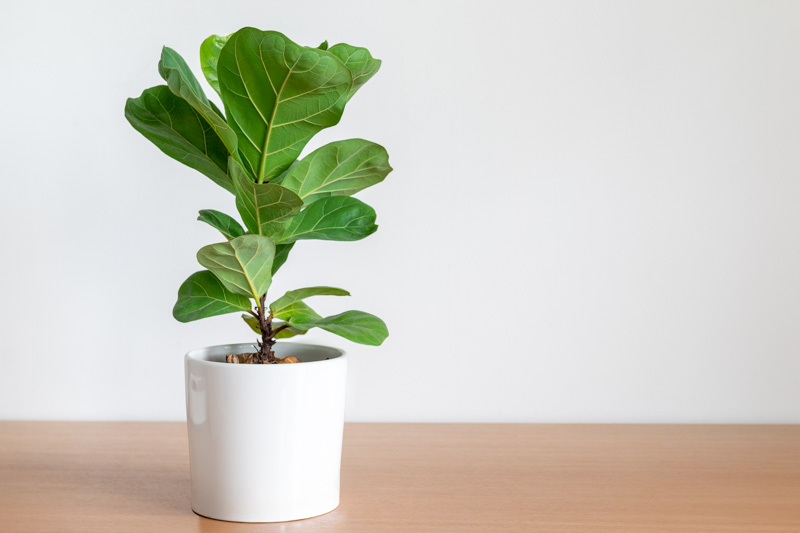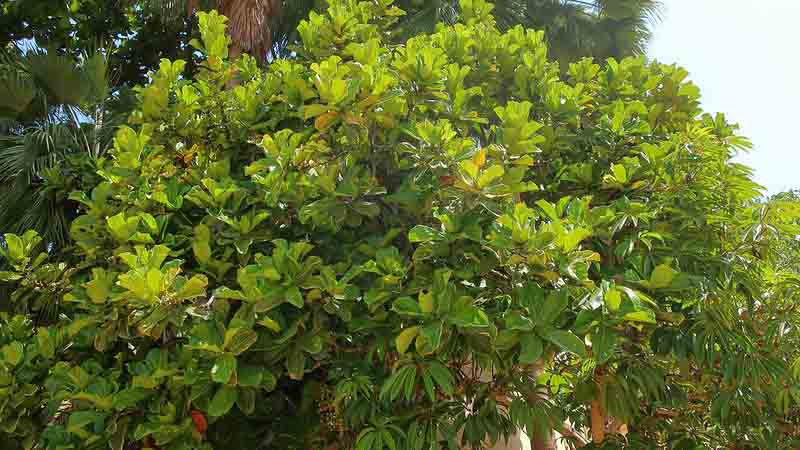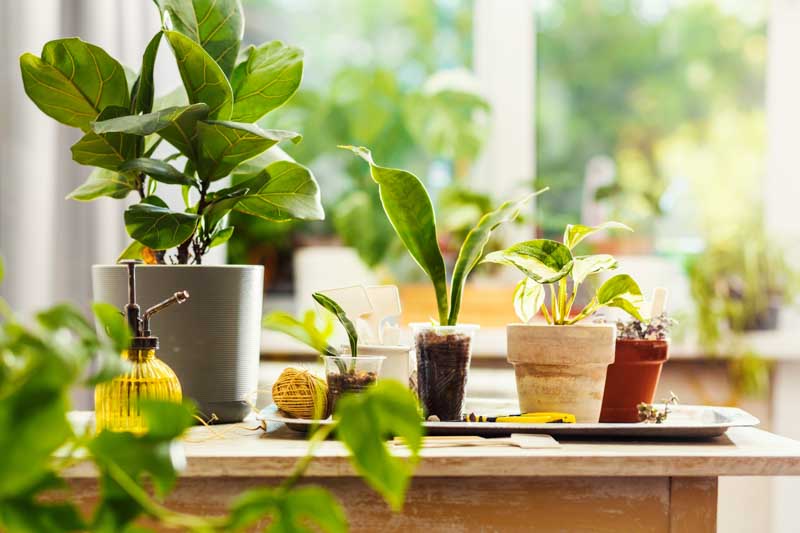Fiddle-leaf Fig, Banjo Fig, Fiddle-leaved Fig Tree, Lyre Leaf Fig Tree, Lyre-leaved Fig Tree
The Fiddle-Leaf Fig, scientifically known as Ficus lyrata, is not only a popular houseplant but also an interesting species in the plant world.
Ficus lyrata is renowned for its large, glossy, veined, fiddle-shaped leaves. It’s a striking plant that adds a tropical flair to any interior setting. With proper care, a Fiddle Leaf Fig plant can live up to 25-50 years, sometimes even longer, making it a long-term companion for plant enthusiasts.
Native: Originally from the rainforests of West Africa, the Fiddle-Leaf Fig thrives in warm, humid environments. It belongs to the mulberry and fig family Moraceae.
Plant Type and Habit: This fig species is a robust evergreen tree that can grow into a tall tree of upright-spreading, irregular habit in its natural habitat. It typically has an upright and bushy habit when cultivated as an indoor houseplant.
Size: In the wild, the Fiddle-Leaf Fig can grow 25 to 50 feet tall (7.5 to 15 m). However, it typically reaches 6-10 feet (1.8 to 3 m) in height when grown indoors.
Flowers: This fig tree blooms, but its flowers are insignificant and rarely seen, especially on indoor plants. It produces small, non-edible fig fruits, which are rare in non-tropical environments or indoors.
Foliage: The most distinctive feature of the Fiddle Leaf Fig is its large, glossy, dark green, violin-shaped leaves. These leaves can grow up to 18 inches (45 cm) long and 12 inches (30 cm) wide, making them a dramatic and stylish addition to any indoor space.
Bark: The bark is smooth and light grey, becoming more textured with age.
Uses: Primarily used as an ornamental plant, it’s popular in homes, offices, and commercial settings for its aesthetic appeal. It is also favored as an ornamental tree in subtropical and tropical gardens.
Award: Recipient of the prestigious Award of Garden Merit of the Royal Horticultural Society.
Hardiness: The Fiddle-Leaf Fig is not frost-tolerant and does best in USDA zones 10-12. It must be kept indoors or in a warm, sheltered spot in cooler climates as it does not tolerate temperatures below 50°F (10°C).
Toxicity: This plant is toxic to humans, cats and dogs if ingested, leading to symptoms such as oral irritation, excessive drooling, and vomiting. Handling precautions, like wearing gloves, is advisable, especially during pruning or propagation, as the sap may cause skin irritation.
Deer and Rabbit: Generally not bothered by deer and rabbits, making it suitable for gardens prone to these visitors.
Drought: The Fiddle Leaf Fig is moderately drought-tolerant once established.
Invasiveness: Ficus lyrata is a fast-growing tree that can propagate through both seeds and cuttings. If left unattended, it may develop a dense canopy, potentially competing with native vegetation. However, like other Fig species, it relies on a specific pollinator for successful seed production and can be managed using herbicides.
Benefits: Like many houseplants, Ficus lyrata is known to help improve indoor air quality. It filters out airborne toxins such as formaldehyde and benzene.

Caring for a Fiddle-Leaf Fig indoors requires attention to several key aspects of its environment.
Light: Place your Fiddle-Leaf Fig in a spot with plenty of bright, indirect sunlight. Avoid direct sunlight, as it can scorch the leaves. West-facing or south-facing windows are ideal.
Soil: Use a well-draining potting mix. A mix designed for indoor plants or a blend including peat moss and perlite works well.
Watering: Water your plant when the top inch of soil becomes dry. Ensure the pot has good drainage to avoid waterlogging, which can lead to root rot. Overwatering is a common mistake with Fiddle-Leaf Figs.
Humidity: These plants enjoy a humid environment, similar to their native tropical habitat. If your home is dry, especially in winter, consider using a humidifier or placing a water tray near the plant.
Temperature: Keep the temperature between 60-75°F (15-24°C). Avoid placing your plant near drafts or heat sources, as sudden temperature changes can stress the plant.
Fertilizing: During the growing season (spring and summer), fertilize every 4-6 weeks with a diluted, balanced fertilizer. Do not fertilize in the fall and winter when the plant’s growth slows down.
Pruning: Prune your Fiddle-Leaf Fig to maintain its shape and remove dead or damaged leaves. This can also encourage growth. To make clean cuts without causing damage, position your pruning shears about an inch (2 cm) away from the trunk.
Repotting: Repot the plant every 2-3 years to prevent it from becoming root-bound and to refresh the soil. Choose a pot that is only slightly larger than the previous one.
Leaf Care: Dust the leaves regularly to keep them clean and improve photosynthesis. You can gently wipe them with a damp cloth.
Rotation: Regularly rotate your plant to ensure even growth on all sides, as it will tend to grow towards the light source.
Avoid Moving Frequently: Fiddle-Leaf Figs don’t like to be moved often. Once you find a good spot with the right conditions, try to keep it there.
Monitoring and Adjusting: Observe your plant’s response to its care. Yellowing leaves can indicate overwatering, while brown, crispy leaves might suggest underwatering or too much direct sunlight.
Propagation: Propagate by seed, leaf-bud, or semi-hardwood cuttings.

Caring for a Fiddle-Leaf Fig outdoors can be a bit different from indoor care, particularly because you have to consider more environmental variables.
Climate Suitability: Fiddle-leaf Fig thrives in warm, humid climates. It is best suited to USDA zones 10-12. If you live in a region with cooler temperatures, you must bring your plant indoors during the colder months.
Light: Place your plant in full sun to partial shade. Direct sunlight, especially during the hottest part of the day, can scorch the leaves. A spot with morning sun and afternoon shade is often ideal.
Watering: Requires regular watering. Water when the top inch of soil feels dry. Ensure good drainage to prevent root rot.
Soil: Plant in well-draining soil. If planting in a container, use a high-quality potting mix. For in-ground planting, ensure the soil is rich and well-aerated.
Temperature: These plants do not tolerate frost. If temperatures drop below 50°F (10°C), it’s best to move the plant indoors or provide some form of frost protection.
Fertilizing: Feed your Fiddle-Leaf Fig during the growing season (spring through summer) with a balanced, slow-release fertilizer.
Pruning: Regular pruning can help maintain the desired shape and size, especially as outdoor plants may grow larger and faster than indoor ones.
Mulching: Apply mulch around the base of the plant to help retain soil moisture and regulate soil temperature.
Winter Care: In areas with mild winters, protect the plant from cold snaps with frost cloths. In colder areas, it’s essential to bring the plant indoors or into a greenhouse.
Adaptation Period: If you’re moving a plant from indoors to outdoors, do it gradually. Start by placing it outside for a few hours each day, gradually increasing its time outdoors to acclimate it to the new conditions.

Ficus lyrata, or the Fiddle-Leaf Fig, can be susceptible to certain pests, diseases, and common problems, especially when its growing conditions are not ideal.
Spider mites: These tiny pests can cause yellowing or speckling on leaves. You may also see fine webs. Increase humidity around the plant and wipe the leaves with a damp cloth. If infestation persists, use insecticidal soap or neem oil.
Mealybugs: These small, white, cottony pests suck sap from the leaves, weakening the plant. They can be removed with a cotton swab dipped in rubbing alcohol or treated with insecticidal soap.
Thrips: Thrips are tiny insects that cause silvering, stippling, or distortion of leaves. Combat them with insecticidal soap or neem oil, and regularly wipe leaves to prevent infestations. Isolation of affected plants is also recommended to prevent spread.
Scale insects: These look like small, brown, bumpy spots on stems and leaves. They can be scraped off gently or treated with neem oil or insecticidal soap.
Root rot: Overwatering can lead to root rot, a serious condition that can kill the plant. Signs include yellowing leaves, wilting, and a musty smell from the soil. Prevent it by ensuring proper drainage and allowing the soil to dry between waterings.
Leaf spot: This can be caused by either fungal or bacterial infections, leading to brown or black spots on the leaves. Improve air circulation, avoid wetting the leaves, and remove affected leaves. Fungicide or bactericide may be needed in severe cases.
Dropping Leaves: Sudden changes in environment, underwatering, or overwatering can cause leaf drop. Ensure consistent watering, avoid moving the plant too often, and keep it away from drafts.
Brown Leaf Tips: This can be a sign of under-watering, low humidity, or too much fertilizer. Adjust your watering routine, mist the leaves, or reduce fertilizing.
Yellow Leaves: Overwatering is a common cause. Allow the soil to dry out more between waterings.
Stunted Growth: This could be due to lack of light, improper watering, or the need for fertilization. Make sure your plant is in a well-lit area, adjust your watering schedule, and consider a balanced fertilizer.
Leggy Growth: If the plant is stretching towards the light, it might not be receiving enough sunlight. Move it to a brighter location.
Is a Fiddle-Leaf Fig High Maintenance?
In ideal conditions, with stable lighting, temperature, and humidity, Fiddle-Leaf Figs can indeed be relatively low-maintenance, especially if they’re acclimated to their environment.
Is Fiddle-Leaf Fig a Good Indoor Plant?
Yes, Fiddle-Leaf Figs are excellent indoor plants. They are visually striking with their large, glossy leaves and can adapt well to indoor environments. As long as their basic needs for light, water, and humidity are met, they can thrive indoors.
Why Are Fiddle-Leaf Figs So Hard to Care For?
The perception of Fiddle-Leaf Figs being hard to care for often arises from their sensitivity to changes. They thrive on consistency—steady light, careful watering, and stable environmental conditions. Challenges usually arise when these conditions fluctuate or when the plant is moved frequently.
What Not to Do with a Fiddle-Leaf Fig?
| Hardiness |
10 - 12 |
|---|---|
| Heat Zones |
7 - 12 |
| Climate Zones | 22, 23, 24, H1, H2 |
| Plant Type | Houseplants, Trees |
| Plant Family | Moraceae |
| Genus | Ficus |
| Common names | Fiddle-Leaf Fig |
| Exposure | Full Sun, Partial Sun |
| Season of Interest |
Spring (Early, Mid, Late) Summer (Early, Mid, Late) Fall Winter |
| Height |
6' - 50' (180cm - 15.2m) |
| Spread |
2' - 35' (60cm - 10.7m) |
| Maintenance | Low |
| Water Needs | Average |
| Soil Type | Chalk, Clay, Loam, Sand |
| Soil pH | Acid, Alkaline, Neutral |
| Soil Drainage | Moist but Well-Drained |
| Characteristics | Plant of Merit, Showy, Evergreen |
| Tolerance | Drought |
| Garden Uses | Beds And Borders, Patio And Containers |
| Garden Styles | Mediterranean Garden |
| Hardiness |
10 - 12 |
|---|---|
| Heat Zones |
7 - 12 |
| Climate Zones | 22, 23, 24, H1, H2 |
| Plant Type | Houseplants, Trees |
| Plant Family | Moraceae |
| Genus | Ficus |
| Common names | Fiddle-Leaf Fig |
| Exposure | Full Sun, Partial Sun |
| Season of Interest |
Spring (Early, Mid, Late) Summer (Early, Mid, Late) Fall Winter |
| Height |
6' - 50' (180cm - 15.2m) |
| Spread |
2' - 35' (60cm - 10.7m) |
| Maintenance | Low |
| Water Needs | Average |
| Soil Type | Chalk, Clay, Loam, Sand |
| Soil pH | Acid, Alkaline, Neutral |
| Soil Drainage | Moist but Well-Drained |
| Characteristics | Plant of Merit, Showy, Evergreen |
| Tolerance | Drought |
| Garden Uses | Beds And Borders, Patio And Containers |
| Garden Styles | Mediterranean Garden |
How many Ficus lyrata (Fiddle-Leaf Fig) do I need for my garden?
| Plant | Quantity | |
|---|---|---|
| Ficus lyrata (Fiddle-Leaf Fig) | N/A | Buy Plants |
Create a membership account to save your garden designs and to view them on any device.
Becoming a contributing member of Gardenia is easy and can be done in just a few minutes. If you provide us with your name, email address and the payment of a modest $25 annual membership fee, you will become a full member, enabling you to design and save up to 25 of your garden design ideas.
Join now and start creating your dream garden!
Create a membership account to save your garden designs and to view them on any device.
Becoming a contributing member of Gardenia is easy and can be done in just a few minutes. If you provide us with your name, email address and the payment of a modest $25 annual membership fee, you will become a full member, enabling you to design and save up to 25 of your garden design ideas.
Join now and start creating your dream garden!